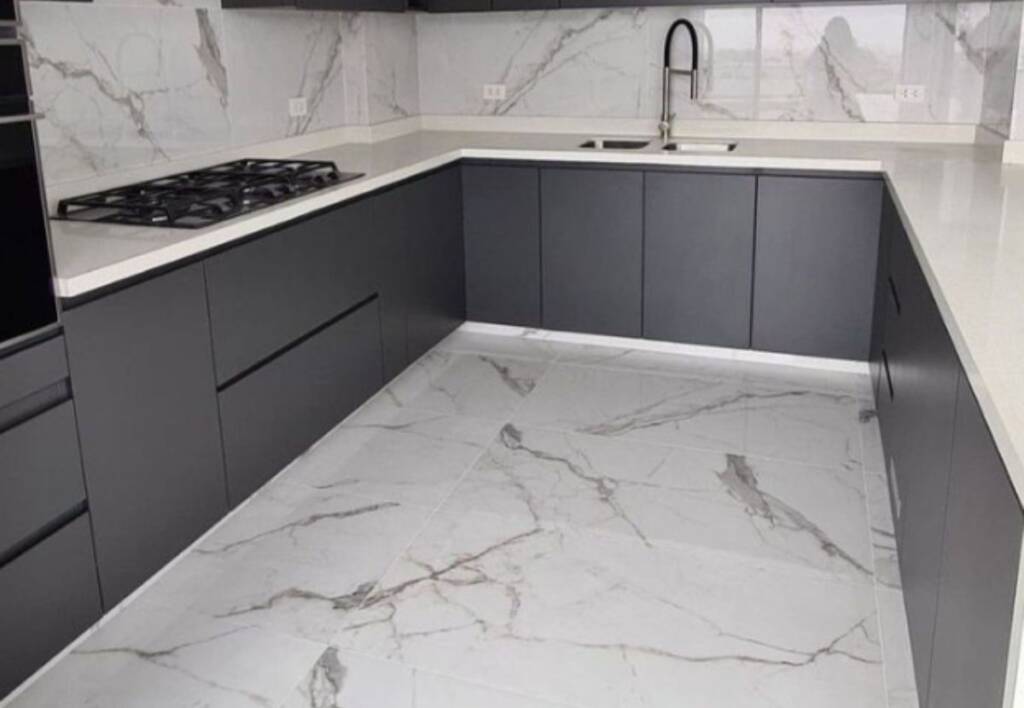Let’s skip the fluff. You want a tiled kitchen floor, and you want to know what it’s going to cost. Fair. But the first cost isn’t just a number you pull off Google. It’s tied to what you’re doing, what materials you’re using, and who’s doing the work. And when we’re talking about something that you walk on every day, in a room that sees heat, water, spills, and foot traffic, you better not cheap out on the wrong things.

The Price Tag (Range You Can Expect)
In New Jersey, kitchen tile floor installation costs generally range between $10 to $25 per square foot, all-in. That’s materials and labor. But that range can swing depending on a few things. Some people try to get it done cheaper. Some spend more. You’re not just paying for tile, you’re paying for what’s under it, how it’s installed, and how long it lasts.
So let’s say your kitchen is around 150 square feet, you’re looking at $1,500 to $3,750. Give or take. Some jobs come in a little under, some way over. There’s no flat number because every kitchen is different.
What Affects the Cost (And Why It Matters)
1. Tile Type
Big one. Ceramic tile is cheaper, around $1 to $5 per sq ft for materials. Porcelain? A little more $3 to $10. Natural stone? You’re in a whole different league $7 to $20+ per square foot just for the tile. Labor’s more expensive on those, too. Not because we want it to be, but because stone is harder to cut, heavier to move, and has to be handled a certain way.
2. Subfloor Condition
No one talks about this enough. If your subfloor is uneven, damaged, or just plain wrong for tile, it has to be fixed first. You can’t slap tile over crap and expect it to last. We might need to level it, put in a cement board, or use a decoupling membrane. That can add a few hundred bucks. But if you skip it, the tiles can crack. Then you’re ripping it all up later.
3. Layout and Design
Straight lay is the fastest and cheapest install. You start adding in diagonal patterns, borders, and mosaic inlays, that’s extra labor. It’s not just “a little tile here and there.” It’s precision work. You want it to look right? Takes more time. More time = more money.
4. Demolition and Prep
Old tile? Sheet vinyl glued to plywood? That stuff has to come out. And removal takes time. Sometimes there are surprises underneath, like water damage or mould. That’s more labor. More material. You won’t always know until we start.
5. Who’s Installing It
Here’s the deal: you hire a guy who tiles on the side for cheap, which might save you money upfront. But if he doesn’t know about expansion joints, thinset coverage, subfloor movement, or the right grout spacing? That floor might not last two years. Then you’re doing it all over again, and spending double. So yeah, labor isn’t a place to cut corners.
Mistakes People Make When Budgeting
- Not including prep. They think the tile cost is the tile plus the installation. It’s not. Prep is a huge part of the job.
- Buying the exact amount of tile. Always buy 10-15% extra. You’ll need it for cuts, mistakes, and future repairs.
- Using the wrong installer. Friend of a friend, handyman from Facebook, sometimes it works, sometimes it’s a mess. And the title’s not forgiving. One mistake shows up forever.
- Cheap thinset and grout. Not glamorous stuff, but if it fails, your whole floor is compromised. Pay for the good stuff.
What Happens If You Try to Cut Corners
If you cheap out on prep, tiles start to lift. You’ll see cracks in grout lines. Or worse, full tiles cracking right across. If the subfloor wasn’t reinforced properly, the floor moves. And tile hates movement.
You also can’t use mastic (glue) on a kitchen floor unless it’s specifically rated for it. Some guys do it anyway. Quick, easy, and wrong. Eventually, the glue breaks down from heat or moisture. Then you’ve got hollow spots. And that popping noise when you step on a tile? That’s your install telling you it’s failing.
When to Do It
Best time? When your kitchen is already under renovation, if you’re changing cabinets, appliances, or redoing plumbing, do the tile right after rough work but before cabinets go in. That way, you get a clean surface wall-to-wall and don’t have to tile around things later.
If you’re keeping the cabinets and doing just the floor, it’s more work you’ll need to tile up to them and make sure transitions are clean and level. Not impossible, just something to plan for.
Final Thought: Not a Pitch, Just Real Talk
At Precise Tile & Stone, we’ve been doing this long enough to know where the problems show up. If the job’s done right, you won’t think about that floor for the next 20 years. If it’s done wrong, you’ll think about it every time you walk into the kitchen.
Tile floor installation isn’t just about laying squares in a straight line. It’s about layers, prep, planning, and doing it right the first time. Cost matters of course it does. But what you’re paying for is peace of mind. A solid floor. Even. Clean. Built to last.
If you’ve got questions, reach out. We’ll walk you through it with no pressure.